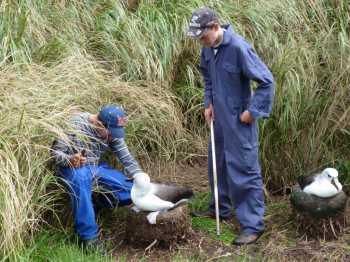Nightingale Island is one of the Tristan group of islands in the South Atlantic, which forms part of the United Kingdom Overseas Territory of St Helena, Ascension and Tristan da Cunha.
Members of the Tristan da Cunha Conservation Department undertake annual monitoring of Nightingale’s Endangered Atlantic Yellow-nosed Albatrosses Thalassarche chlororhynchos in terms of the Tristan and Nightingale Islands Wildlife Monitoring Manual Research Report. In September 2011 approximately 1000 occupied nests were counted around the four molly ponds at the island’s centre at the commencement of egg laying (click here).
Information for the 2012/13 breeding season is now available in a report written by Katrine Herian, latterly the Royal Society for the Protection of Birds (RSPB) Project Officer seconded to the Tristan Conservation Department. A total count of 976 breeding pairs for the four ponds was made on 6 October last year by Julian Repetto and Kirsty Green of the Tristan Conservation Department, suggesting that the population is currently stable, following an historical decline from estimates made in the early 1970s (click here).

Tristan Conservation Department members banding Atlantic Yellow-nosed Albatrosses at
The Ponds on Nightingale Island in 2011
Photograph by Katrine Herian
The Atlantic Yellow-nosed Albatross is endemic to the Tristan da Cunha islands with an estimated total annual breeding population of 27 500 - 41 600 pairs, although there remains considerable uncertainty around this estimate.
Selected References:
Cuthbert, R., Ryan, P.G., Cooper, J. & Hilton, G. 2003. Demography and population trends of the Atlantic Yellow-nosed Albatross. The Condor 105: 439-452.
Herian, K. 2013. Penguins, petrels and plants. Conservation Department report. Tristan da Cunha Newsletter 52: 32-33.
Sommer, E., Cuthbert, R. & Hilton, G. 2008. Tristan and Nightingale Islands Wildlife Monitoring Manual Research Report. RSPB Research Report 33: 1-36.
John Cooper, ACAP Information Officer, 9 February 2013

 English
English  Français
Français  Español
Español